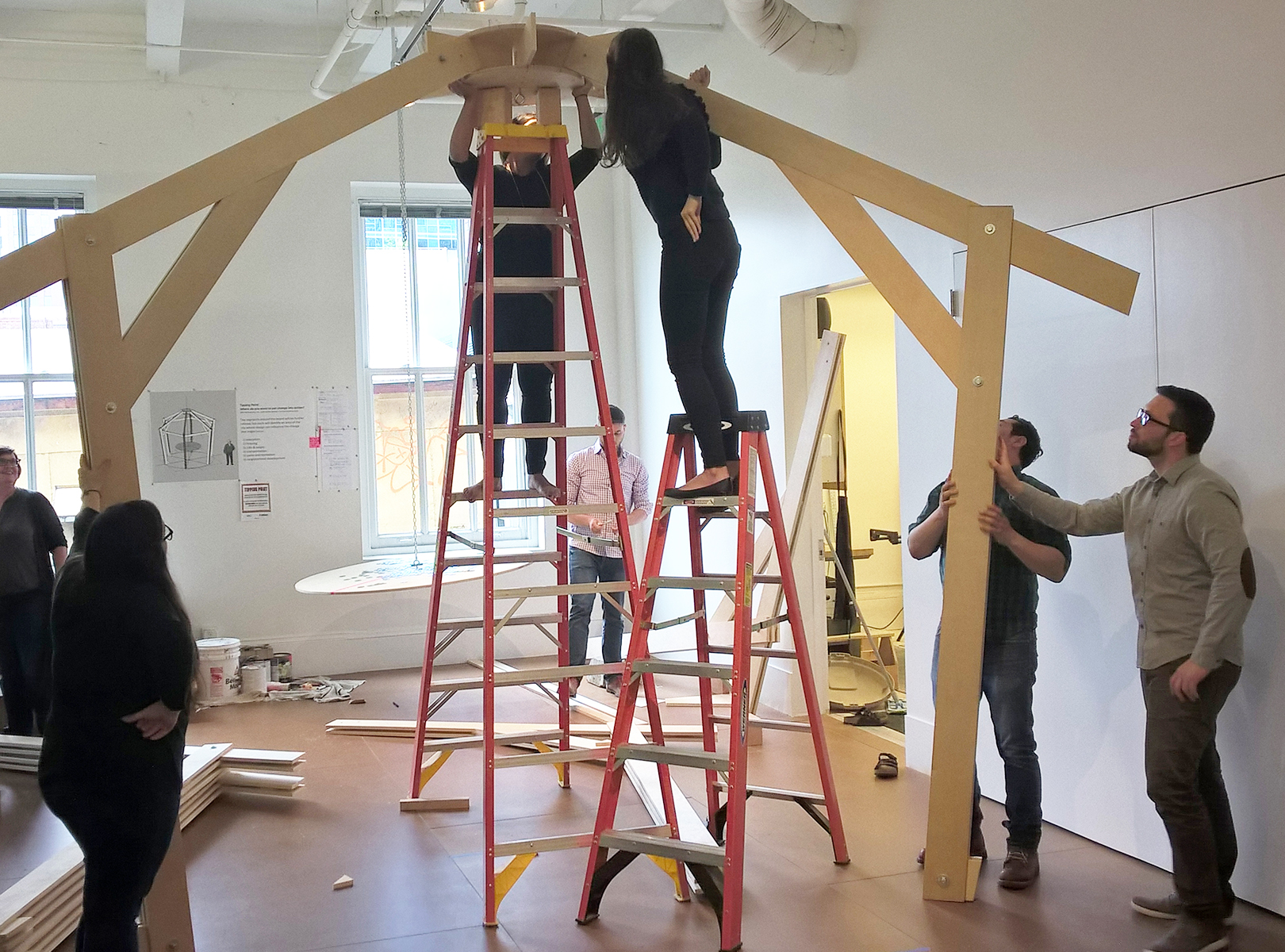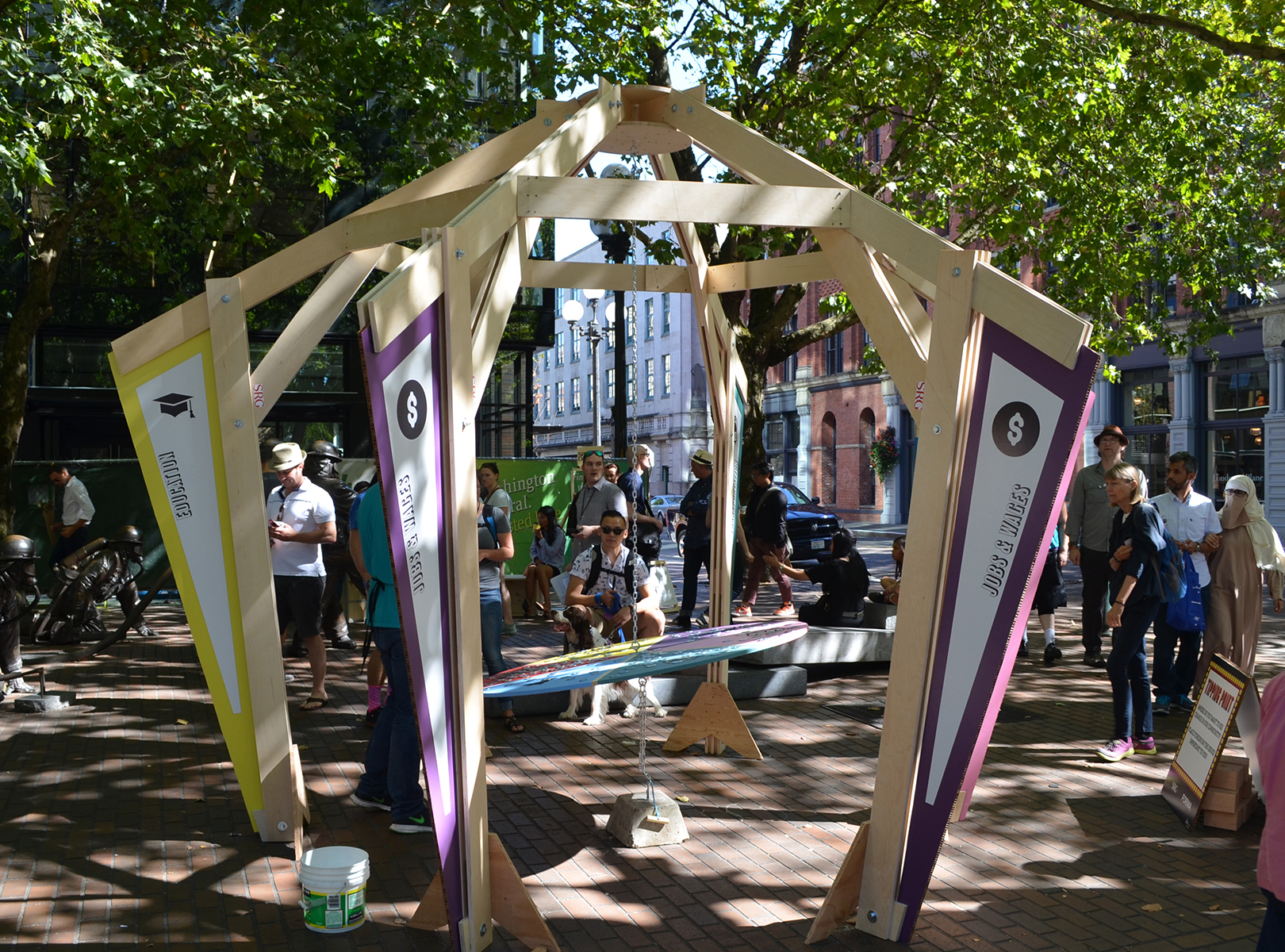Design work doesn’t happen in a vacuum. Someone is going to interact with the things we design, and the challenge is to ensure these things have a positive impact on the communities they are intended to serve.
As a relatively new addition to SRG, I really wanted to be a part of the team that created the installation for the Seattle Design Festival. It was an opportunity for me to experience firsthand the team dynamic at SRG. In the weeks leading up to the event (particularly the frenzied last few days before set up), our studio’s work tables were dedicated to our installation, which we named Tipping Point.

Every September since 2011, the Seattle Design Festival, presented by Design in Public and AIA Seattle, brings together designers, community members, experts, and city officials to celebrate how design improves the quality of our community.
This year’s Seattle Design Festival theme, Design Change, proposed that design can maximize the public benefits of change while empowering those communities most impacted by that change. The Festival and its participants investigated and celebrated the role of design in an evolving place through their installation pieces.

As the festival approached, we were fortunate to have Barney Mansavage lead the team from conception to construction of our installation. All materials for the project were donated by Forma Construction, United Reprographics, and SRG. Everyone chipped in to help plan the design, prepare the materials, and get the structure standing, but credit is also due to Arnulfo Ramirez and Uwe Bergk, who spent several days doing a significant amount of the actual construction work.
Uwe and Barney did a great job scheduling and planning, you know. Everyone took their turn to help build it, and it was such a team effort. You know, projects like this take time. You need to set things in order for it to work; it’s time management over a few weeks, not just a few days. We couldn’t have done this in just two days!
Arnulfo Ramirez
“Tipping Point: Where do you want to put change into action?” was a large-scale reinterpretation of the boardwalk arcade game “coin pusher.” Rather than coins being pushed by a mechanical broom off of a platform, participants place coins, represented by thick, metal washers to vote for change. Tipping Point’s platform was a large, circular disc suspended by a chain and split into six segments: education, housing, neighborhood development, jobs and wages, transportation, and parks and recreation. The platform would tip as more washers were added, leading to a cascade of change falling towards the heaviest segment and eventually clattering to the ground.
Over the weekend, people engaged with our installation in interesting ways. Sometimes a group of little kids would walk up and wreak havoc by grabbing and yanking the platform. “Let’s use our change, not our bodies, to vote for change,” we would remind them as we re-stabilized the platform and collected the fallen washers. I guess that’s one way to reflect on social disruption. There’s a sociopolitical message in there somewhere.
One young boy, maybe seven or eight years old, was particularly passionate about parks and the environment and camped out for about twenty minutes, so he could cajole and argue with other participants about how “if you don’t have a good environment, what’s the point of a job or an education or anything. Without trees, it’s pretty much game-over.”
I loved it. He completely got our concept.
He wasn’t the only one. Our installation prompted a lot of conversation as participants engaged with Tipping Point, especially when the washers ran out.
At this point, the game reached an equilibrium with no tipping point. Now participants were challenged to remove “resources” from one segment in order to prioritize another segment. This prompted new discussions about limited resources. A family weighed the pros and cons of reducing funding for housing in order to improve education, and a high school student challenged her friends that if they improved the job market without providing education for people to take those jobs, it was pretty much wasted effort.

The conversations this game inspired exceeded my expectations. It reflected the festival’s goal for engagement – the board would evolve and tip with each new participant’s action and provided a space for interaction and conversation.
It was also fun. Especially when it tipped and everyone hooted as the washers hit the ground.
While the six categories we chose are certainly important challenges faced by any modern city, we also had individuals ask:
Where’s health care?
Where’s criminal justice?
Where’s solutions to poverty and homelessness?
No one person has a single answer about how our communities must change or even what changes are the most vital. Tipping Point provided a low-pressure and fun way to exchange ideas about what our community needs.
This is exactly the sort of thing that invigorates me: seeing creativity spark cooperation and engagement. Design is a form of connection, and it was really motivating for me to see the staff from SRG and the participants at the Design Festival come together and make a meaningful connection for change.
As a side note, the structure can be dismantled and reassembled for future use, so we’ll keep you posted on future appearances of Tipping Point!



